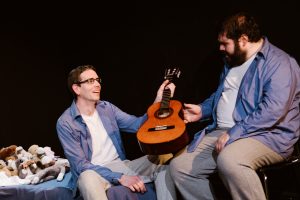So Imagining Liam, Company D’s newest project is now coming to the end of its two week run in The Teachers Club. Towards the end of a run I like to put out there what exactly I was aiming to achieve with a play that I write. I wouldn’t do that early in the run, only at this stage as it’s unlikely that any more reviewers will come along now, but audiences still will roll in to see the last three shows and perhaps they might like to come with some of these thoughts in mind. We did have three great online reviews of the show from respected sources, but I would have very much liked some of the mainstream newspaper’s theatre critics with their vast experience to have seen and commented on the work, but alas, despite many emails, we didn’t register as important to them this time around. Company D plays certainly have aroused the interest of the establishment in the past and I certainly hope they will again.
So in brief my aim with Imagining Liam was to explore the nature of self-knowledge, or perhaps better-said, self-truth. In this frenzied world, I find that people are too quick to define themselves. They do this on social media especially, setting up “profiles” for themselves that then project them to the outside online world. Further than that, people entrench themselves in beliefs far too quickly also, and usually those beliefs have not come from a source of truth, or even from oneself, but rather from the media or from another radicalised voice. For example, a voice tells us that all Catholic Clergy are violent child rapists and the Church is evil, and another tells us it’s just a small minority and the Catholic Church is really very wonderful. Depending on who we listen to and believe, we entrench ourselves in our positions and stick to them, no matter what, even though we have never gone looking for the real truth, beyond the media, who let’s remember have a job which is to “sell” their news and is often deeply agenda driven.
Moreso, we do not look within ourselves for truth either. We don’t take the time to stop and meditate and think about the real us, the real self within, the child that still lives deep within us. If we take the time to listen to it, it will whisper and speak again.
So Robert in the play has been imprisoned for killing a child while driving drunk. Sure, that’s an interesting frame for a play, but Liam is an Imagining. We never see him and we never hear his voice, other than through Robert. Robert comes to us as a victimised, homophobic, sexist bully who has been thrown in the can for having a few pints. He is entrenched in his hatred of religion, fags and women, all of whom are bitches because his own girlfriend has left him during his trial. “Frailty, thy name is woman”.
However, within the space of a couple of scenes, and indeed often within single scenes, I have illuminated the contradictory nature of Robert. He emerges not as homophobic, but in fact quite the opposite. Not sexist, but a defender of women’s piss-weak gender roles as handed to them by religion and society, and his anti-religious fervour is based on quite thoughtful problems with indoctrination and the ill effects that can have on society.
His cellmate, Steve, is as one reviewer said, “remarkably zen”, yet here’s a man whose past haunts him and who fears the outside world. He too is “a walking contradiction, partly truth, partly fiction” Kris Kristofferson.
As the play progresses and children’s toys proliferate around the space, we see the children within Steve and Robert. We see the little boy who needs his mother, who needs to be forgiven, who needs love and acceptance. We see him them both play

cry, child like, at different moments and in different ways. As Robert slowly realises that his entrenched positions might be flawed, that his memory of that fateful day that he killed Liam might be invented as a self-protection mechanism, we see him look within. What better place to do that? A prison cell. Four years to think. Four years to take the time to see within. Four years to listen to the voice of the child within whisper and then speak. Time to take the time to go down those rabbit holes.
We choose what rabbit holes we go down. That’s all it is. That’s all I think it is anyway.
Imagining Liam. The Teachers Club Theatre, 36 Parnell Square West, Dublin 1. 7:30pm shows nightly till Saturday June 10.